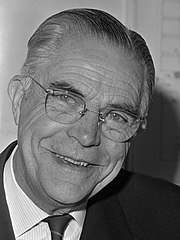Pim Boellaard's Human Design Chart
5/1 Emotional ManifestorDutch entrepreneur, soldier, politician and resistance man.
Boellaard was a member of the Boellaard family and a son of Willem Hendrik Cornelius Boellaard (1866-1951), officer, last lieutenant general titular and deputy governor of the residence, and Margaretha Antoinette Römer (1879-1973). He married in 1929 Anna Louisa baroness van Heeckeren (1907-1991), art painter; they had a son whose wife, Maria Julie Boellaard-Stheeman (25 July 1937, Amsterdam), was the lady-in-waiting of Queen Beatrix. Boellaard himself became lifelong befrienderd with her father Prince Bernhard after WW2.
Boellaard came from a family whose male members had been general since 1790, but chose a career with an insurance company, after he had completed his studies at the Nederlandsche Handels-Hoogeschool, the later Erasmus University of Rotterdam. In his study years, Boellaard was a member of the Rotterdam Student Corps.
In 1939 he was mobilised as a reserve captain at the artillery. At the German invasion in 1940 he was involved in the counterattack against the Germans who had taken the airfield Ockenburg. After the capitulation of the Dutch armed forces on May 15, 1940, Boellaard became regional commander of the order service in the Utrecht region. The order service was a resistance organisation of reserve officers of the Dutch army.
In May 1942 Boellaard was arrested and ended up in the Scheveningen prison (Oranjehotel). Although he was questioned on May 11, he did not talk. He was sentenced to death anyway.
When Boellaard was removed from his cell on 14 May, he thought his last hour had been beaten. However, he was cut and shaved and then taken to the Clingendael estate. Han Jordaan underwent the same treatment. At Clingendael there was an extensive interview with Himmler, who was briefly in The Hague to discuss with the Nazi top the latest details of the journeys of Jews to the extermination camps. When Boellaard and Jordaan arrived, a conversation with Himmler followed, including Hanns Rauter, Otto Schumann, Wilhelm Harster and Karl Wolff were present. They walked around the park during this conversation so they could not be bugged. Later it appeared that Boellaard and Jordaan were invited because Himmler sometimes wanted to meet a prototype resistance man.
Via Camp Amersfoort, Boellaard ended up in concentration camp Natzweiler-Struthof. Boellaard made an impression in these difficult circumstances, because he managed to preserve his dignity and reconcile the contradictions between Dutch communists and the Orange Kingdom supporters.
When the Allies advanced in September 1944, Boellaard was transferred to Dachau. Here he was involved with the International Prisoners Committee, an illegal consultation between prisoners of different nationalities. After the liberation of Dachau, the repatriation of the Dutch ex-prisoners was difficult. Boellaard travelled to the Netherlands and, with the support of Prince Bernhard, managed to provide the necessary means of transport.
After the war, Boellaard was an insurance director and member of the state for the VVD in the Provincial States of Utrecht and he played an important role in organisations for former prisoners. He was, among other things, the founder of the Dutch Dachau Committee.
Boellaard died at old age on 27 January 2001 in De Bilt. In April 2013, Boellaard’s son Willem donated the blue-gray striped camp coat of his father to the Resistance Museum in Amsterdam and the lid of the coffin in which he kept his personal belongings in Dachau. On the inside of that lid he had drawn a chessboard. His name, W. Boellaard, and his camp number, 100649, and the letters BLÄ 20 (Block älteste) were also mentioned.
Link to Dutch Wikipedia
Discover More Famous People
Browse and analyze over 55,000 public figures and celebrities.
Ra Uru Hu
5/1 Manifestor
Martha Stewart
4/6 Manifestor
David Lynch
4/6 Generator
Barack Obama
6/2 Projector
Steve Jobs
6/3 Generator
Vladimir Putin
5/1 Manifestor
Kim Kardashian
3/5 Generator
Michael Jackson
1/3 Projector
Marilyn Monroe
6/2 Projector
Ariana Grande
2/4 Projector
Oprah Winfrey
2/4 Generator
Johnny Depp
2/4 ManifestorWhat is HumanDesign.ai and how does it work?
Curious what makes Pim Boellaard tick? HumanDesign.ai instantly maps their exact birth data into a fully interactive clickable bodygraph chart, letting you hover or tap every center, channel, and gate for plain-language explanations. Bella, the platform’s built-in AI guide, adds context in real time, translating complex mechanics into everyday insights so you can see how Pim Boellaard’s strengths, challenges, and life themes play out on-screen.
The same tools are waiting for you. Generate your own Human Design Chart in seconds, open a library of 2000+ suggested questions, and chat with Bella as often as you like to decode your design, daily transits, and even relationship dynamics.
Want to compare energies? Save unlimited charts for friends, family, or clients, then ask Bella to reveal compatibilities, composite patterns, or coaching tips, all in one conversation thread.
Start free with core features, or unlock our Personal and Pro plans for deeper dives: unlimited Q&A, celebrity chart search spanning 55,000+ public figures, white-label PDF reports, branded content generation, and a professional profile with built-in booking for practitioners. Whether you’re exploring your own potential or guiding others, HumanDesign.ai delivers an ever-expanding toolbox of AI-powered insights—no spreadsheets, no jargon, just clarity at your fingertips.
Ready to see yours? Signup for FREE today!

